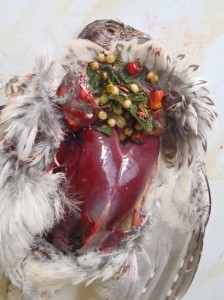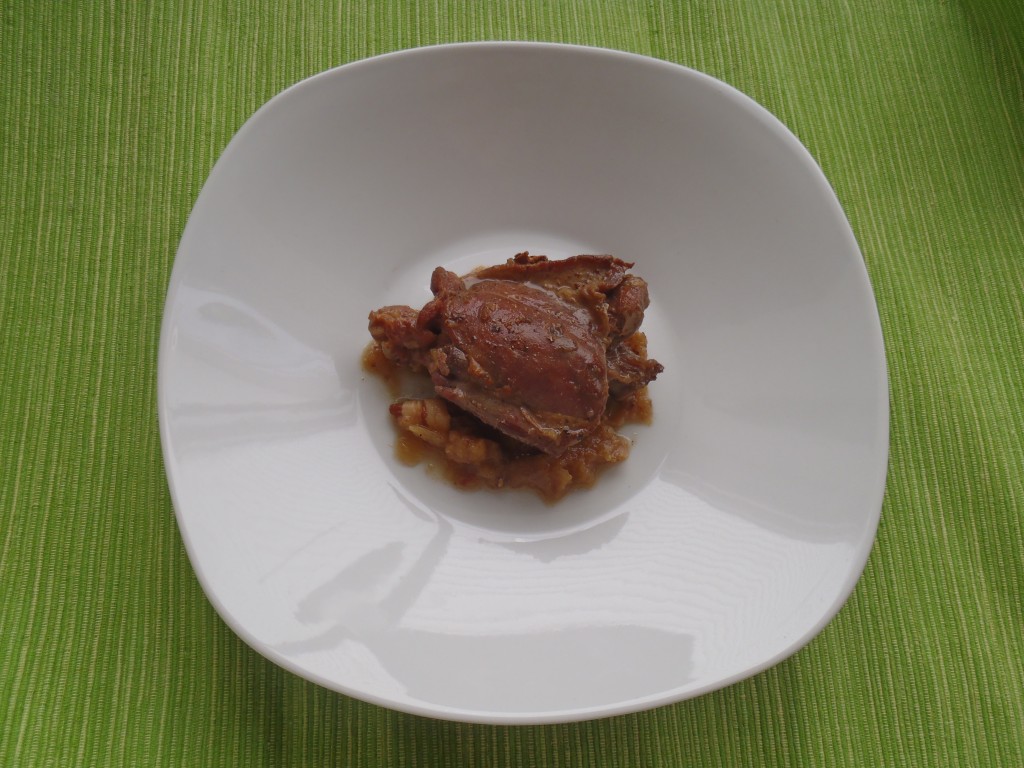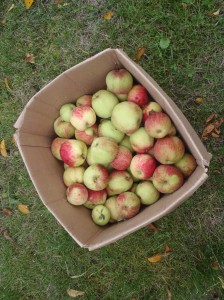Step One: Acquire Grouse
A friend’s father, Mr. McLarney, hunts game birds with his English pointer. I had never, not once, paused to consider the signficance of common canine descriptors like pointer, setter, and retriever, until Mr. McLarney’s hunts were explained to me. The dog walks a ways in front of him, and when it comes upon a bird it stops and “points”: it aims its snout at the prey. Mr. McLarney moves within range and readies his gun, then makes a call to the pointer. At the signal, the dog scares the bird into flight, so that Mr. McLarney can pull it from the sky with his shotgun.[1]
Mr. McLarney trained his pointer in his backyard with a fishing rod and a feather. I have a hard time imagining what those sessions might have looked like.
This fall I received two grouse from the McLarneys. They had been shot the day previous. The condition of receiving the birds was that I provide the McLarneys with a recipe. Apparently Mr. McLarney is such a skilled hunter that Mrs. McLarney has run out of ways to prepare the birds.
Step Two: Clean Grouse
The most common way to clean game birds is to remove the skin, which takes all the feathers with it. I spread the feathers on the breast to expose the skin, which on this bird was paper thin and easily torn.
 Pulling the skin and feathers away from the breast, I had my first glimpse of the crop, which is a pouch at the base of the throat that moistens the food before it is sent to the stomach and gizzard. As I removed the skin, I broke the wall of the crop, exposing a handful of bugs, berries, and leaves that released a pungent aroma into my kitchen. This discovery affected me. Not because it was grotesque, but because later, when eating the meat, I could taste that same sourness I smelled in the crop. The picture at left could be titled, “Why game meat tastes different than farmed meat.”
Pulling the skin and feathers away from the breast, I had my first glimpse of the crop, which is a pouch at the base of the throat that moistens the food before it is sent to the stomach and gizzard. As I removed the skin, I broke the wall of the crop, exposing a handful of bugs, berries, and leaves that released a pungent aroma into my kitchen. This discovery affected me. Not because it was grotesque, but because later, when eating the meat, I could taste that same sourness I smelled in the crop. The picture at left could be titled, “Why game meat tastes different than farmed meat.”
The next step was gutting, which was easier than I anticipated. I cut around the anus, then slid my fingers through the incision and into the chest cavity. The organs separated easily from the walls, and came out in a fairly uniform piece.
Step Three: Cook
One of the main reasons I was excited to receive the grouse was because this would be one of the few times in my life that I would get to cook an old bird.
Let me explain.
Almost every chicken in the grocery store was killed about one month after it hatched. Young animals have tender flesh, and many of their bones and joints are still made of flexible cartilage. Next time you are breaking down a chicken, observe how the keel bone (sternum) is still pliable and lustrous, almost like plastic.
Older birds have much tougher flesh, their bones are solid, and their joints have little cartilage. These birds need long cooking and moist heat. Chances are you will never find an old bird in a grocery store, which is unfortunate, because we have inherited recipes, like coq au vin, that depend on them. If you were to try a traditional recipe for coq au vin with a young chicken, the lengthy braising would leave you with mushy meat.
I am very grateful to the McLarneys. This was my first experience plucking and gutting birds, and my first taste of wild poultry (and buckshot). As promised here is a recipe that I think will suite Mr. McLarney’s palate. It is based on faisan à la normande, or “Norman pheasant,” the word “Norman” simply indicating that there are apples in the dish.
Mrs. McLarney’s Apple-Braised Grouse (or Pheasant)
Ingredients
- a few thick slices of bacon, cut into small pieces
- half an onion, diced
- a grouse (or pheasant): two breasts and two legs
- half a cup of white wine or cider
- three apples, peeled, cored and quartered
- two cups stock (ideally made from the bird you are cooking, but chicken stock would work fine)
Process
- Sweat bacon pieces until they are lightly browned and all their fat has rendered into the pot. Remove the pieces of bacon from the pot.
- Crank the heat and deeply brown the grouse. Remove the grouse from the pot.
- Lower the heat and sweat the onion in the same pot until translucent.
- Deglaze the pot with white wine or cider.
- Return the bacon and grouse to the pot. Add the apples.
- Add the stock and bring to a boil, then turn the heat down to a simmer.
- Cover the pot and simmer until the grouse is tender, maybe two hours. The apples should break down into a sauce that can be served with the bird.

1. After learning that pointers point and setters set, I spent the next hour looking up the etymology of every breed of dog I could think of, just to make sure there wasn’t an easily understood meaning to their name that I was missing. “Poodle” is derived from the German word “pudeln,” meaning “to splash in water,” which makes sense, as poodles were originally bred as retrievers for hunting water fowl. Shitzu is mandarin for “Lion Dog,” as apparently those pups were bred to resemble the lions in traditional Chinese art.
Addendum: Apples
Ask, and it shall be given you
-Matthew 7:7, also Kevin Kossowan
 We received the grouse at the height of apple season, so the apple-braise was a no-brainer.
We received the grouse at the height of apple season, so the apple-braise was a no-brainer.
I just wanted to mention that Lisa and I don’t have our own apple tree, but this year we asked some tree-owning acquaintances if we could partake in their bounty. Overwhelmed with deteriorating fruit, they happily obliged us, as you can see at left.
This fall Kevin drew a lot of attention to the amount of fruit that grows in Edmonton, and I just wanted to corroborate his statement that, regardless of how much or how little you speak with your neighbours, they are probably eager to share their crop with you.